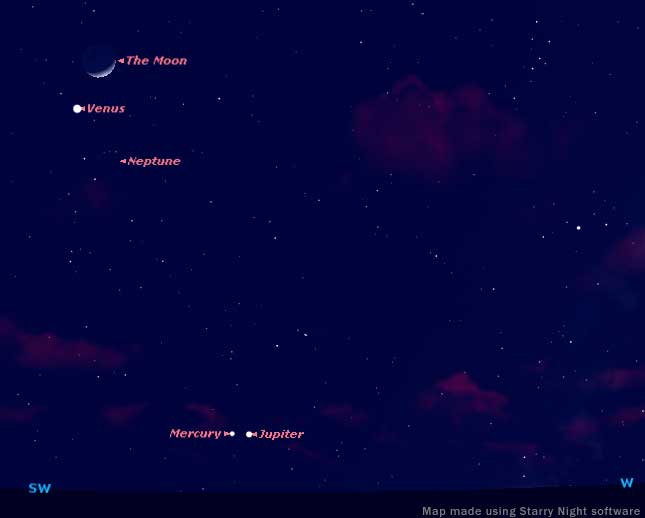Celestial Show Set for New Year's Eve

A delightful display of planets and the moon will occur on New Year's Eve for anyone wishing to step outside and look up just after sunset.
Venus, brighter than all other planets and stars, will dangle just below the thin crescent moon in the southwestern sky. It'll be visible -- impossible to miss, in fact -- just as the sun goes down, assuming skies are cloud-free.
Soon thereafter, Mercury and Jupiter will show up hugging the south-southwestern horizon (just above where the sun went down) and extremely close to each other. Jupiter is very bright and easy to spot; Mercury is faint and harder to see, but it'll be apparent by its location just to the left of Jupiter.
Jupiter and Mercury will set less than an hour after the sun, so timing your viewing just after sunset is crucial. You'll also need a location with a clear view of the western horizon, unobstructed by buildings, trees or mountains.
All the planets, along with the moon and sun, traverse an arc across our sky called the ecliptic, which corresponds to the plane in space that they all roughly share. For this reason, you could draw an imaginary line from the general location of Venus and the moon, down through the other two planets, and the line would point to where the sun went down. This line could also initially help you find Jupiter and Mercury.
Weather permitting, you can get a preview of the sky show on Tuesday, Dec. 30. On this evening, the planets will be in nearly the same place they'll be on Dec. 31, but the moon will be midway between Venus and the Mercury-Jupiter pairing.
One last trick:
Get the Space.com Newsletter
Breaking space news, the latest updates on rocket launches, skywatching events and more!
Venus is so bright you can see it during daylight if you know where to look. Given Venus' proximity to the moon on New Year's Eve, this would be an excellent moment -- just before sunset -- to use the moon to help you find Venus and gain bragging rights for being one of the few people to be able to claim seeing more than one planet during the daytime (Earth being the other one).
Join our Space Forums to keep talking space on the latest missions, night sky and more! And if you have a news tip, correction or comment, let us know at: community@space.com.

Rob has been producing internet content since the mid-1990s. He was a writer, editor and Director of Site Operations at Space.com starting in 1999. He served as Managing Editor of LiveScience since its launch in 2004. He then oversaw news operations for the Space.com's then-parent company TechMediaNetwork's growing suite of technology, science and business news sites. Prior to joining the company, Rob was an editor at The Star-Ledger in New Jersey. He has a journalism degree from Humboldt State University in California, is an author and also writes for Medium.









